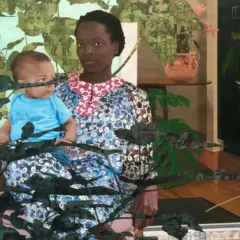[Evan offers a crisp review of a wide-ranging art crawl, highlighting favorites and weak spots, and commenting on the crawl’s effectively loose organization. — the aArtblog editors]
One week after hardy and well-trained participants braved the pavement to complete the famous New York City Marathon, I completed a hefty trek of my own–The New Yorker’s Passport 2014 arts and culinary crawl through the Lower East Side and SoHo. A fully immersive day of gallery-hopping and tasty sampling, Passport left me with eyes and mind as worn as my legs and feet–the proximity of spaces was deceiving on paper, but I was regardless left with all senses satiated, if not overloaded, thanks to an ultra-hip and uber-indulgent wrap party.
Beginning the journey
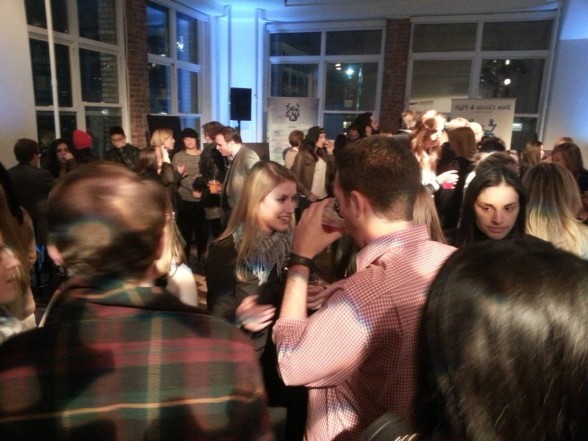
At the end of the day, 25 stops and 25 stamps filled my nicely assembled “passport,” a booklet distributed at the event headquarters: Broome Street’s White Box Art Center. Here, the day began with trying not to spill lovely Mexican hot chocolate and “pan de muertos” on Cavellini collages (no damage done). The booklet served as both notepad and social currency for eventgoers (“look how many galleries I’VE been to!”) but most enjoyably functioned as a receptacle for each gallery’s personalized ink stamp, which occasionally outshone the work on the walls.
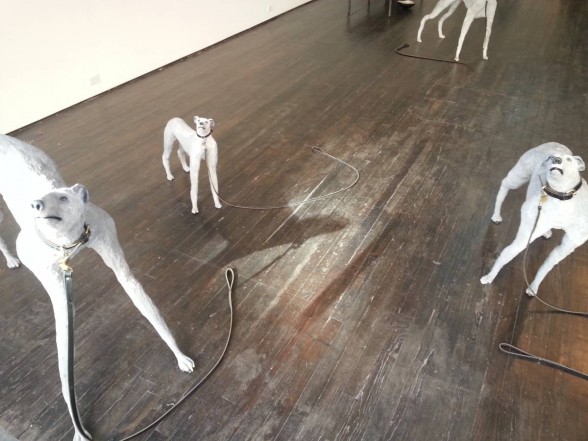
The first cluster of spaces was a mixed bag. Elizabeth Jaeger’s transformation of Jack Hanley Gallery into a chic loft adorned with Modernist furniture and fur accoutrements offered unsettling counterpoint in the form of a multitude of incredulous and sinewy plaster greyhounds–their collective glassy gaze hit me like a wall immediately upon my crossing the gallery threshold and held me in my tracks. The hounds, unflinching, as if in reclamation of the spaces that we humans meticulously decorate and dictate, remind us of how the other half lives–and that everything that goes up must eventually come down.
Time, memory, identity–and a werewolf
Marlborough Broome Street, on the other hand, struggled to impress me with a display of Alan Belcher paintings. The East Village hero of the ’80s hung a series of works depicting desirable and expensive sneakers arranged in a way that brought to mind the shoe closet of a celebrity–part utility and part display–but failed to clear the corporate hurdle it sought to critically discuss (Belcher’s stock market chart paintings in the rear of the gallery were slightly more exciting).
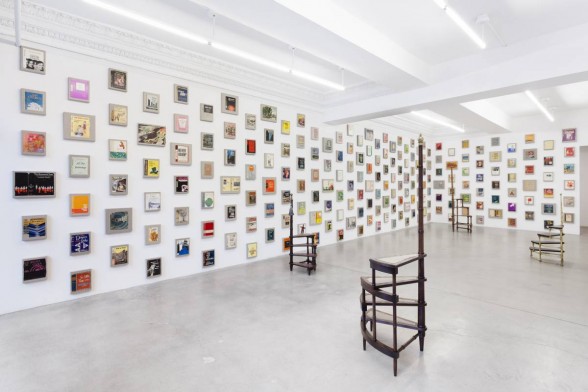
The next few stops were unanimously enticing–Eleven Rivington, split between two spaces a block apart, featured meditations on time by Valeska Soares. In the first gallery, a single gold pocket watch, hour hand removed, hung low on a lengthy chain from a circular ceiling track on which it slowly moved in an otherwise sparse, white room. Walking into the silence of this environment was striking, a reminder of both the persistence and slowness of time, ambivalent to an outside world concerned with speed and control. The accompanying walls were packed with 365 book covers and jackets, each pertaining to past, present, or future in a narration of impermanence.
Salon 94’s two galleries, one on Freeman and one on Bowery, held exhibitions that were as disparate as they were immersive. Jessica Rankin filled the Freeman room with truly gorgeous prints, collages, and watercolors exploring mapping and coding, utilizing text that reads like the thoughts that traipse through your head in that ethereal transition from waking to sleeping life. I was impressed by her search for the origin and nature of memory, assisted by imagery of constellations as delicate and mysterious as our neurological freeways.
The Bowery space led the viewer down a curtained hallway and toward a screening room glowing with pale light. Inside, digital artist and animator Takeshi Murata’s deeply unnerving “OM Rider” played on repeat–a slow and steady story of a delinquent werewolf’s eventual murder of a frighteningly cynical-looking old man. The film made up for its lack of dialogue with perpetual synth noise and maddeningly effecting sound work; I left feeling unsettled and paranoid. Murata is a fresh and talented contributor to the rollicking video art movement.
Invisible Exports held a promising Nick Doyle solo show, Steven, about the artist’s temperamental alter ego, but its assemblages and dioramas always felt a little too polished and high-budget–self-indulgent instead of nuanced in its efforts to unnerve the viewer. The show came across as just as two-faced as the Hollywood of which “Steven” is a product. Regardless, I am interested to see where Doyle takes his aesthetics in the future–the duality of this original/alter identity is fascinating.
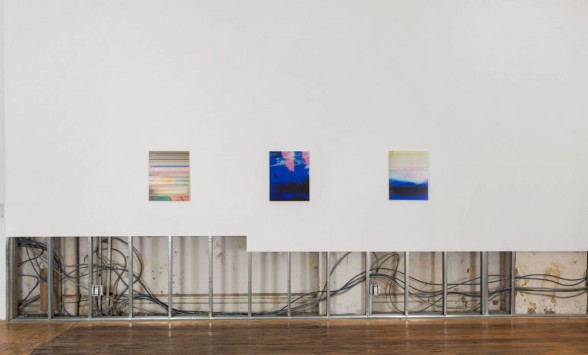
The most challenging “paintings” I saw were James Hoff’s at Callicoon Fine Arts. Super-glossed enamel and aluminum works depicted the product of a virus-injected computer host file–parasitic implants yielding wonderfully varied color and texture-scapes, geographical and the right kind of retro, all while maintaining a steady narrative questioning the making of art in the digital age. The space was cleverly glitched as well–sections of drywall removed according to the artist’s viral morphing of a photograph of the gallery.
IKEA, interrupted
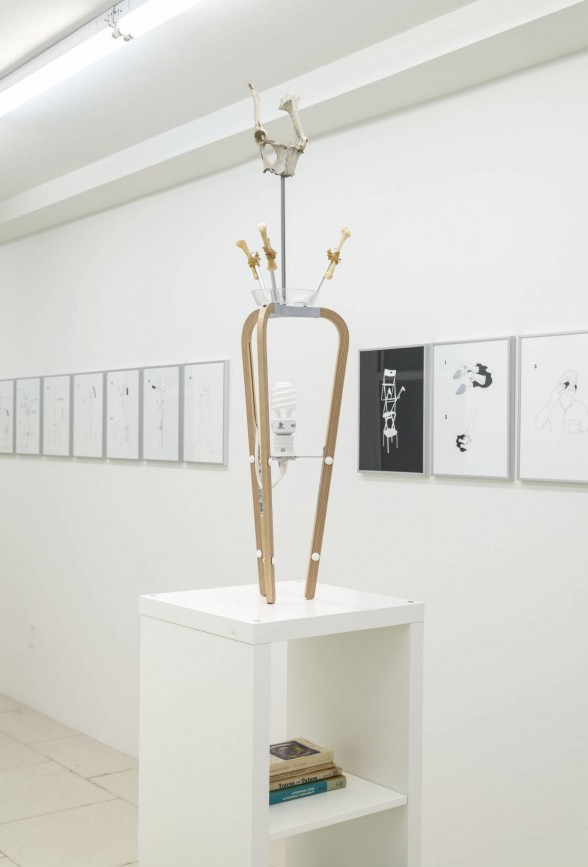
Courtesy the artists and Rawson Projects, New York.
This leads us to what I found to be the primary highlight of the tour: Rawson Projects, presenting Clive Murphy and philosopher Aengus Woods’ outstanding DIWIF: Demonic Interventions With IKEA Furniture, a darkly comedic, tongue-in-cheek critique of IKEA’s utopian vision of a world united by minimalism and devoid of individualism, a populace suckling at the teat of horribly complicated instruction manuals–the stuff of nightmares.
This is absurd, of course, but in the best way. Pagan and Satanic totem-like objects are constructed from fragments of Scandinavian dressers and tables, strung with goat sinew and bones; lovely white bookshelves are stacked with titles such as Dealing With Death. On the walls are re-illustrated IKEA instructions for the construction of said objects–they are disturbing, yet I cannot help but laugh (“How to Sacrifice Your Goat”!). This work is profoundly rooted in a critique of groupthink consumerism and the cultural appropriation of value, but has a sense of humor that makes it relevant and palatable…even with the smell of boiled bones and tendons not quite gone from the room.
A number of less noteworthy shows dotted the route intermittently–nothing was bad, really–but I emphatically went the distance and finished at another evocative location. Sara Greenberger Rafferty’s solo show at Rachel Uffner Gallery was a fresh spin on her gender- and sexuality-fueled knack for performance, this time working with alternative printing processes. Most successful were her life-size prints of doors, with text such as “Audience Entrance,” or simply the icons for “male” and “female” on plastic-y substrates, distorted by an overall look halfway between the results of a computer glitch and the look of paper that’s been soaking in water too long–saturated and sagging. The show is mildly repulsive, demands curiosity, and rewards close inspection.
I often wondered how many of the attendees were there for the art, and how many to eat and talk and look like they knew about art–which can be the downfall of any attempt to fuse social gathering and legitimate critical viewing. The success here was in the loose organization of the crawl–no guides, no required check-ins, and no obligations. Want to look at art, and really look at it? Go for it. Want to make chocolate truffles and eat fancy brisket sliders while you bid on art? Please, by all means. It was pleasure when it needed to be and criticism when I wanted it to be.
The culminating wrap party at Dune Studios, a spacious 7th-floor loft in SoHo, was exactly as decadent and electrifying as I expected–artisanal local fare, presented by Smorgasburg, and plentiful drinks and spirits replenished what was spent in a day of walking; the people-watching was superb; and I left already anticipating next year’s incarnation.





